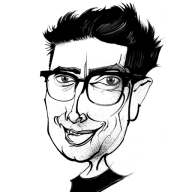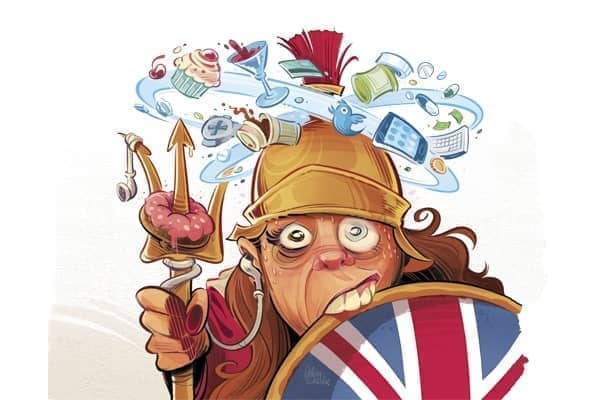Two stories, side-by-side in the Sunday paper I was looking at online. The first — ‘Strip Dame Dopesick of her title’ — was a report that the families of victims of opioid addiction were campaigning for Dame Theresa Sackler, whose family profited unimaginably from marketing addictive legal painkillers, to be stripped of her title. The second was the story of how the writer and TV presenter Richard Osman had spoken on BBC Radio Four of struggling with an addiction to crisps, chocolate and biscuits for four decades. He compared his relationship with food to an alcoholic’s with booze: ‘The addiction is identical.’
There’s a school of thought that will see no connection between these stories; that thinks it ridiculous to compare a luminary of light-entertainment struggling to resist scoffing a four-pack of Mars Bars with a jonesing OxyContin addict or a long-haul alky shuddering into withdrawal in a locked ward. There is, indeed, a school of thought that thinks there’s no such thing as addiction at all — that it’s simply a failure of willpower or backbone or self-control, a medicalised alibi for selfishness. And, sure, it’s true that addiction is a tricky concept to pin down — but you’d have to be proof against observable reality to think that it does not exist. Nor that being the host of Pointless can insulate you against it, or the seeming innocuousness of crisps and chocolate make them proof against becoming the objects of dependency and abuse.
To me, one of the most poignant passages in Martin Amis’s memoir Experience is his description of finding his father, mouth so crammed with sweeties he looked like a basketball. What, Martin asked, was going on? ‘It took him about ten minutes of disciplined mastication before he could reply. “Seems to calm me down,” he said, and started loading up again. He ate for comfort; the tranquillising effects of starch and glucose helped to allay fear.’
I write as one who has had his own brush with the booze (three years sober, ho ho: send Crunchie Rocks); and whose breakfast vodka habit gave way sinuously to cheap chocolate, nicotine, videogames and anything else that can give a bang of dopamine or a moment out of time. You don’t know what dignity in recovery looks like till you’ve seen me get on the outside of a family-size bar of Dairy Milk Marvellous Creations. Bet I’d have gone like gangbusters for OxyContin if it had crossed my path. Addiction isn’t fussy. Your best bet, if you ask me, is to switch to something that kills you slowly rather than quickly.
There was a time when people thought addiction more or less inhered in a substance (heroin: very addictive; celery: less so) and, in talking about ‘addictive painkillers’ above, I’ve used that shorthand. Then they wondered about patterns of genetic predisposition, about addicts processing substances differently, about addiction as a ‘disease’ that marked the drunk or the junkie as separate from the blessed herd of the normal. No dice there either. The twelve-step orthodoxy that alcoholics are marked by an ‘allergy’ to booze (a ‘doctor’s opinion’ from the 1930s) may be therapeutically effective but, as I understand it, it’s medical nonsense.
It certainly seems to be true that it’s easier to become dependent on heroin than celery; but that may be because the former answers a particular need in the addict more directly and powerfully than the latter, rather than because it has a special chemical property called addictiveness.
It doesn’t even have to be a substance. It can be a behaviour — gambling, gaming, self-harm, debt, sex, jogging.
It’s a behaviour that seeks to medicate fear, sorrow, boredom, regret, anomie, heartbreak, or the existential heebie-jeebies: take your pick. That desire — the desire to take your eye off the ball for a bit — is not unique to people we think of as addicts. You can call it a spiritual condition, or a neurological one, or a psychological one… or you could see it as, in one form or another, a universal. Looked at that way, the difficulty isn’t finding a wide enough definition of addiction to encompass both the victims of Sackler profiteering and the author of The Thursday Murder Club; it’s finding a narrow enough definition to make them significantly different from the rest of us.
The mechanisms of addiction — craving, overconsumption, dependence, shame and furtiveness, the chasing of irretrievable or imaginary highs, the diminishing returns of the old reward loop — are not just a weird deviation from the norm. They are the norm. They’re what the modern economy — and not just the Sackler fortune — is built on. The biggest tech companies in the world are built on the psychology of addiction: the craving for that next notification, that like, that retweet, the ping of an incoming email, the not-quite fulfilment of dinging another level on Candy Crush. And they’re just vanguard refinements in the limitless digital space of an economy already built on the queasy high of retail therapy, fast fashion and sugar-laden ‘treats’. What social science graduates of a certain stripe like to call ‘late capitalism’ depends on creating new and impossible to satisfy desires, and it is extremely good at it. There’s no twelve-step treatment for it, either.







Comments